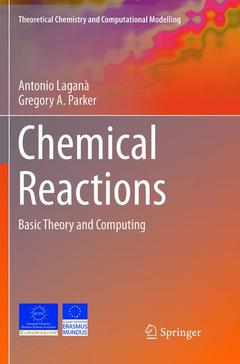Description
Chemical Reactions, 1st ed. 2018
Basic Theory and Computing
Theoretical Chemistry and Computational Modelling Series
Language: English
Subjects for Chemical Reactions:
Keywords
Theoretical Chemistry and Computational Modelling; European Chemistry Thematic Network Association; European Education; Audiovisual and Culture Agency; Molecular modelling of reactions; Potential energy surface reactions; modelling reaction dynamics; semi-classical reactive probabality; quantum computing chemical reactions; introduction to molecular modelling; modelling kinetics; modelling chemical reactions
Publication date: 06-2019
208 p. · 15.5x23.5 cm · Paperback
Publication date: 01-2018
Support: Print on demand
Description
/li>Contents
/li>Biography
/li>Comment
/li>
Methods for computing quantum, classical, and semi-classical reactive probabilities based on the already discussed concepts and tools are also featured and the resulting main typical reactive behaviors are analyzed. Finally, the possibility of composing the computational tools and technologies needed to tackle more complex simulations as well as the various competences and distributed computing infrastructure needed for developing synergistic approaches to innovation are presented.
From the phenomenology of chemical reactions to the study of two body collisions.- A quantum approach to the two body problem.- Ab initio electronic structure for few body systems.- The treatment of few body reactions.- Complex reactive applications: a forward look to Open Science.- Appendices.
Antonio Laganà is Professor of Inorganic Chemistry at the University of Perugia. After his (Theoretical and Computational) Chemistry degree he has been postdoc at the University of Manchester (1977-78) and Visiting Researcher at several Laboratories and Universities (ECSEC, Caltech, Cambridge, Los Alamos, Salamanca, Bristol, CERN, EPCC, Vitoria, FORTH, Barcelona, CNUCE). He has been Director of two NATO workshops and has organized several International Schools and Conferences (among which Molec, Molecular Beams, Gas Kinetics, Stereodynamics, Computational Chemistry, Parallel computing, International Conference on Computational Science and its Applications) His research work has developed in the fields of electronic structure, molecular scattering, dynamics and kinetics, parallel and distributed scientific algorithms, high performance and high throughput computations with particular emphasis to distributed research and education community environments and tools. He has published more than 400 papers and authored 10 books.
Prof. Laganà chairs the Computational Chemistry Division of EUCHEMS, the Virtual Research Community CMMST (Chemistry, Molecular & Materials Sciences and Technologies) of EGI.eu and the Virtual Education Community Standing Committee of ECTN. He has chaired in the past the ECTN Association (2007-2009), the COST Chemistry technical committee (2003-07), the Chemistry Department of the Perugia University (2002-13), the Computer Centre of the University of Perugia (1996-2001) and the Italian Interdivisional group of Computational Chemistry.
Prof. Greg Parker is the George Lynn Cross Research Professor at the Homer L. Dodge Department of Physics and Astronomy in the university of Oklahoma. He obtained his B.S and PhD from Brigham Young University, USA. Prof. Parker is the recipient of the following awards: the George Lynn Cross Research Professorship and the Regents' Award for Superior Research & Creative Activity.
Masters level textbook including basic concepts and examples involved in higher complexity multi-scale simulations
Features simple test cases and problems to facilitate the learning process
Provides an understanding of chemical processes at the microscopic level
Offers a rigorous description of the microscopic dynamics of reactive processes
These books may interest you

Reactive and Functional Polymers Volume TwoModification Reactions, Compatibility and Blends 210.99 €



